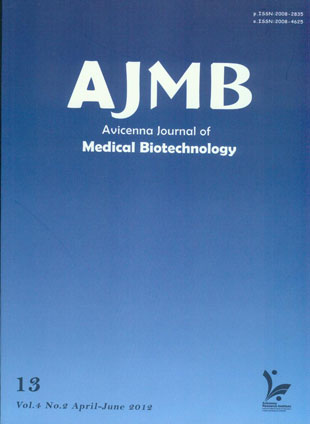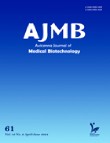فهرست مطالب

Avicenna Journal of Medical Biotechnology
Volume:4 Issue: 2, Apr-Jun 2012
- تاریخ انتشار: 1391/03/10
- تعداد عناوین: 7
-
-
Page 53
-
Page 55Research about potential use of stem cells for the development of germ line cells in vitro had been challenged. In the present study, we reported a novel protocol consisting of cocktail growth factor addition for germ cell differentiation followed by transfection. The cells were purificated based on the expression on the cell surface of a protein. This protein is not present in normal cells of mice and does not interfere with cellular function. This cell surface marker is efficiently recognized by monoclonal antibodies. Bone marrow mesenchymal stem cells derived primordial germ like cells were differentiated to spermatogonial stem like cells by inducer cocktail including Retinoic acid (RA)+Leukemia inhibitory factor (LIF)+Basic fibroblast growth factor (bFgF). Co-culture system was used as a feeder under differentiated cells. A 400 bp fragment of spermatogonia-specific Stra-8 locus was enough to direct gene expression to the germ line stem cells. Stra8-CD4HAglo construct was used for purification of premeiotic differentiated cells. Expression of pluripotency (Pou5F1, Nanog, c-Myc) and specific germ cell)Mvh, Piwil2, Stra-8) genes in each stage were analyzed. The purified cells expressed the known molecular markers of PGC-like cells such as Mvh, Piwil2 & Stra-8. The outcomes of qPCR showed that ratio pluripotency of genes expression in selective group significantly decreased (p≤0.05) in the initial differentiation process. This results showed that ratio of Pou5F1, Nanog, c-Myc, Mvh, Piwil2 & Stra-8 expression to purified PGC-like cells were 0.41, 0.204, 1.1, 0.003, 0.184 and 2.276, respectively. Treatment of cells with RA affected up regulation of Stra-8. Although, c-Myc gene as an oncogenic gene had significantly increased (p≤0.05) at the end of differentiation stage compared to initial phase of study, this level of expression could not be tumorgenic. qPCR results of the differentiation stage showed higher expression of Stra-8 in co-culture+cocktail and co-culture groups, Also, there was a significant difference (p≤0.05) in the expression of Pou5F1 & Nanog. Our results suggest that selection and purification of PGC-like cells based on Stra-8 as a pre-meiotic marker is a useful tool for getting in vitro spermatogonial stem cell. This method facilitates identification of safely differentiated germ cells in vitro.
-
Page 65The aim of the present study was to develop a tissue-engineering approach through alginate gel molding to mimic cartilage tissue in a three-dimensional culture system. The perfusion biomimetic bioreactor was designed to mimic natural joint. The shear stresses exerting on the bioreactor chamber were calculated by Computational Fluid Dynamic (CFD). Several alginate/bovine chondrocyte constructs were prepared, and were cultured in the bioreactor. Histochemical and immunohistochemical staining methods for the presence of glycosaminoglycan(GAG), overall matrix production and type II collagen protein were performed, respectively. The dynamic mechanical device applied a linear mechanical displacement of 2 mm to 10 mm. The CFD modeling indicated peak velocity and maximum wall shear stress were 1.706×10-3 m/s and 0.02407 dyne/cm2, respectively. Histochemical and immunohistochemical analysis revealed evidence of cartilage-like tissue with lacunas similar to those of natural cartilage and the production of sulfated GAG of matrix by the chondrons, metachromatic territorial matrix-surrounded cells and accumulation of type II collagen around the cells. The present study indicated that when chondrocytes were seeded in alginate hydrogel and cultured in biomimetic cell culture system, cells survived well and secreted newly synthesized matrix led to improvement of chondrogenesis.
-
Page 75Hormone-independent prostate cancer cell lines are resistant to antineoplastic drugs, this study sought to determine the usefulness of lithium chloride as an inhibitor of glycogen synthase kinase-3β to increase the cytotoxic effect of doxorubicin, etoposide or vinblastine antineoplastic drugs on DU145 cells. Combination effect was assessed by using low and IC50 doses of drugs + lithium chloride. Subsequently, cell cycle analysis and p53 levels and its subcellular localization as a key regulator of cell cycle were assessed. Lithium chloride showed cytotoxic effect in a dose and time dependent manner (p<0.001). Both drugs doxorubicin and etoposide in combination with lithium chloride showed higher percent of cells in SubG1 compared to control (p<0.001). Combination of IC50 dose of doxorubicin and lithium chloride led to S phase arrest (p<0.001, compared to control, lithium chloride or doxorubicin alone). Moreover, G2/M arrest was significantly increased when low dose of doxorubicin and vinblastine were combined with lithium chloride (p<0.001, compared to control and lithium chloride alone). DU145 cells were highly sensitive to vinblastine and no significant changes were observed when combined with lithium chloride. The IC50 doses of all three drugs combined with lithium chloride demonstrated decreased cell percent in G1 phase compared to control or lithium chloride alone (p<0.001). Moreover, in the presence of lithium chloride there were increased levels of p53 in cytoplasm and nucleus (p<0.05). Our results suggest that combination of lithium chloride with chemotherapeutic agents may increases their cytotoxic effect on hormone non-responsive human prostate cancer cells.
-
Page 89Cholera toxin B subunit (CTB) has been extensively studied as an immunogen, adjuvant, and inducer of oral tolerance in many investigations. Production of CTB has been carried out in the bacterial, plant, insect and yeast expression systems. In this study the expression of the CTB containing a 6XHis-tagged was performed by Escherichia coli (E.coli) M15. The yield of purified pentameric recombinant CTB was about 1 mg/l. Western blot analysis demonstrated that the recombinant CTB was antigenically active. In addition, GM1-ganglioside ELISA showed that recombinant CTB binds to GM1-gangelioside receptor, confirming disulfide bond formation and proper folding of the recombinant protein in E.coli. Overall, in regard to the vast applications of CTB in medicine, this bacterial expression system will be a fast, cost-effective and simple system for production of pentameric CTB and CTB conjugated proteins.
-
Page 95The ataxia telangiectasia mutated gene (ATM), candidate for breast cancer susceptibility gene, encode a 350-kDa protein belongs to the core components of DNA-damage response machinery. Female AT carriers have at least 5-fold increase risk for breast cancer. Reduction in ATM expression is shown in multiple studies in breast tissues. We aimed to perform a research to measure the ATM mRNA expression in peripheral blood cells in breast cancer patients. Peripheral blood sample from 40 newly diagnosed, histologically confirmed female breast cancer patients was collected before surgery. Total RNA was isolated from blood cells using the RNX-Plus solution and reverse transcribed into cDNA. Real-time PCR was performed using the 2-∆∆CT method to calculate relative changes in gene expression by REST software. The Relative Quantitation (RQ) mean was 1.27 with the min. and max. equal to 0.20 and 3.34, respectively. Calculation of patient frequencies in different groups revealed that 17.5% had reduced expression lower than two fold decreases and 15% high expression more than two fold increases, but according to REST software there was no up-regulation or down-regulation compared to normal females. The findings of multiple studies consistent with this study indicate that the ATM gene may play an important role in breast cancer development and progression, and ATM expression is down-regulated in breast cancer tissues. Although, some of the results do not support a suppressor role for ATM in the development of sporadic breast cancer, 17.5% of our patients had under expression of ATM mRNA less than two fold relative to control.
-
Page 103Common Variable Immunodeficiency (CVID) is an antibody deficiency syndrome that often co-occurs in families with selective IgA deficiency (IgAD). This study was designed to investigate the frequency of DR and DQ loci of HLA class II region in common variable immunodeficiency (CVID) patients. Fifteen Iranian patients with CVID or IgAD (mean age 14.6±5.4, range 4-25 years; 9 male and 6 female) and 63 healthy controls were studied. Establishment of B-lymphoblastoid cell lines was performed using Epstein-Barr-virus (EBV) immortalization technique and HLA alleles were typed using polymerase chain reaction based on sequence specific primers (PCR-SSP). DRB1 alleles including DRB1 *04 (p=0.03) and DRB1 *11 (p=0.01) significantly showed higher frequency in the studied subjects. In contrast, DRB1 *301 (p=0.04) and DRB1 *07 (p=0.02) alleles were negatively associated with CVID. For DQB1 and DQA1 loci, DQB1 *0302 (p=0.047) and DQA1 *03011 (p=0.001) demonstrated high frequency in cases, while DQB1 *0201 (p=0.02) and DQA1 *0201 (p=0.01) were detected to be low when compared to controls. Haplotype analysis indicated that frequency of DRB1*04-DQB1*03011-DQA1 *03011 (p=0.02), DRB1 *11-DQB1 *03011-DQA1 *0505 (p=0.047), DRB1 *11-DQA1 *0505 (p=0.04) and DRB1*04-DQA1*03011 (p=0.02) haplotypes were significantly higher in patient group, while only the frequency of the DRB1 *07-DQA1 *0201 haplotype gene was statistically lower in control group (p=0.02). According to the results, it could be deduced that the HLA-DR and DQ loci may contribute to the pathogenesis of CVID or they might be considered as suitable markers for the possibility of the occurrence of this genetic defect.


